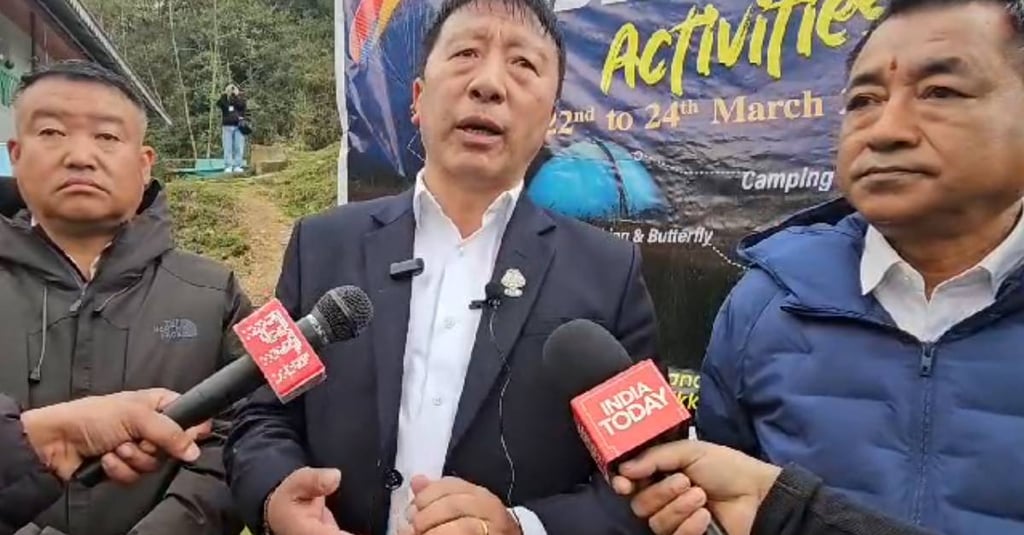Sikkim Tourism Minister on Chiwabhanjyang corridor : Road construction Is nearly complete
The Chiwabhanjyang corridor, particularly the road connecting Uttarey in West Sikkim to Chiwabhanjyang, has been a priority project for the Sikkim government.
LOCAL


To boost rural tourism and international connectivity, Sikkim’s Minister of Tourism, Tshering Thendup Bhutia, highlighted key developments at the Sikkim Rural Tourism Meeting. The event focused on promoting remote villages like Uttarey in the Maneybong–Dentam area, near the Nepal border, and strengthening infrastructure for tourism growth.
Uttarey village, situated in a valley below the international border, is a popular destination known for its natural beauty and cultural richness. One of its main attractions is the Singshore Bridge, the second-largest suspension bridge in Asia. A glass-bottom walkway is being installed on the bridge, allowing visitors to experience breathtaking views of the valley below. With the rising popularity of homestays in the area, the government is working to attract more tourists and provide opportunities for local communities.
The state government, under Chief Minister Prem Singh Tamang’s leadership, has launched the "Sikkim Inspires Go" initiative. This project focuses on empowering unemployed youth and women by training them in various tourism-related activities. The tourism department, as the nodal agency, has identified around 19-20 tourism skills for training. Once trained, these individuals will have the opportunity to work in the tourism sector, whether in Sikkim or beyond.
“We want to ensure that our youth, especially those in remote villages, can build their skills and earn a livelihood through tourism,” Minister Bhutia said. “By promoting homestays and eco-tourism, we aim to showcase Sikkim’s cultural heritage to both domestic and international visitors.”
As part of the initiative, the government organized the Rural Tourism Meet, inviting bloggers, YouTubers, influencers, and major media representatives to highlight the state’s tourism potential. The event also featured a B2B meeting with local tourism stakeholders, focusing on global promotion strategies.
Another major announcement by Minister Bhutia was the progress of the Chiwabhanjyang International Road Corridor, connecting Sikkim to the Nepal border. The road construction is nearly complete, with the main cutting finished and blacktopping in progress.
Once operational, the road is expected to facilitate cross-border trade and international tourism, making Chiwabhanjyang a key transit point. “We are in discussions with the central government to finalize agreements for cross-border trade. We hope for a positive outcome soon,” Bhutia said.
Chiwabhanjyang, also known as Chiwa Bhanjyang or Chiyo Bhanjyang, is a significant mountain pass located on the border between West Sikkim, India, and eastern Nepal. Situated at an elevation of approximately 3,139 meters (10,299 feet) above sea level, it serves as a vital link between the two regions. This pass marks the starting point of Nepal’s Pushpalal (Mid-Hill) Highway, which stretches across the country, while on the Indian side, it connects to the Uttarey-Chiwabhanjyang road, leading to Gangtok, about 170 kilometers away. Historically, the area has been a trekking route and a point of barter trade between border communities, but recent infrastructure developments have transformed its role, boosting prospects for trade, tourism, and regional connectivity.
The Chiwabhanjyang corridor, particularly the road connecting Uttarey in West Sikkim to Chiwabhanjyang, has been a priority project for the Sikkim government. Spanning roughly 18-20 kilometers, this strategic route is designed to enhance cross-border ties with Nepal, opening avenues for commerce and tourism. The road passes through scenic landscapes, including views of Mount Kanchenjunga, the third-highest peak in the world, making it a potential hotspot for ecotourism and adventure activities like trekking and birdwatching. The construction, managed by Sikkim’s Roads and Bridges Department, faced delays due to environmental clearances and challenging terrain but has progressed significantly in recent years.
In addition to rural tourism, Sikkim is also making strides in adventure tourism. The state has introduced bungee jumping and hot air balloon trials to attract thrill-seekers. The government is working on regulatory frameworks to ensure these activities are conducted safely and in an organized manner.
With these initiatives, Sikkim is positioning itself as a top tourism destination, offering a blend of natural beauty, cultural heritage, and adventure tourism. The government’s focus on rural development, infrastructure, and skill-building is expected to bring long-term benefits to the local economy and communities.
